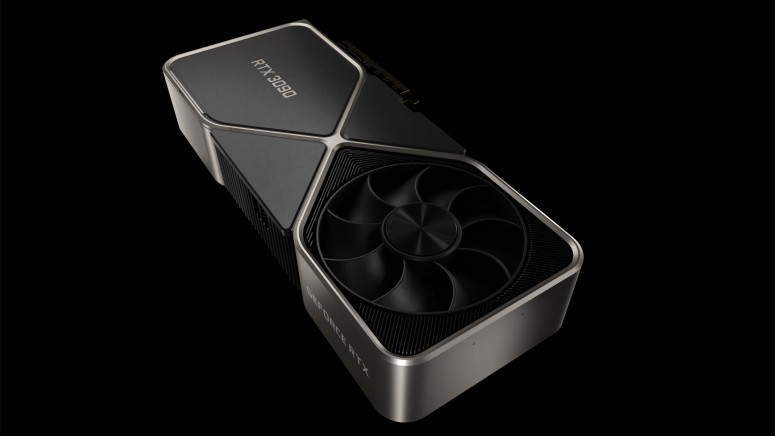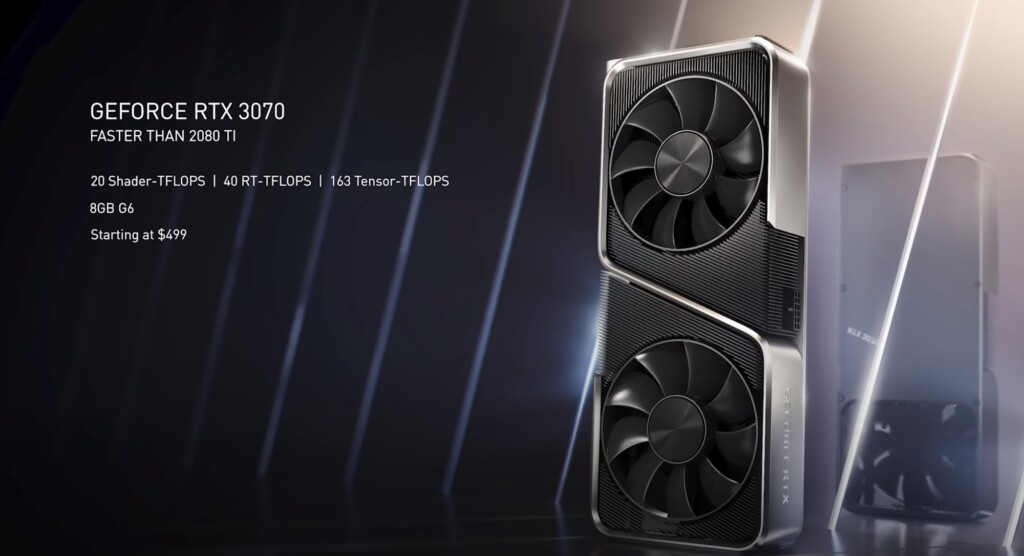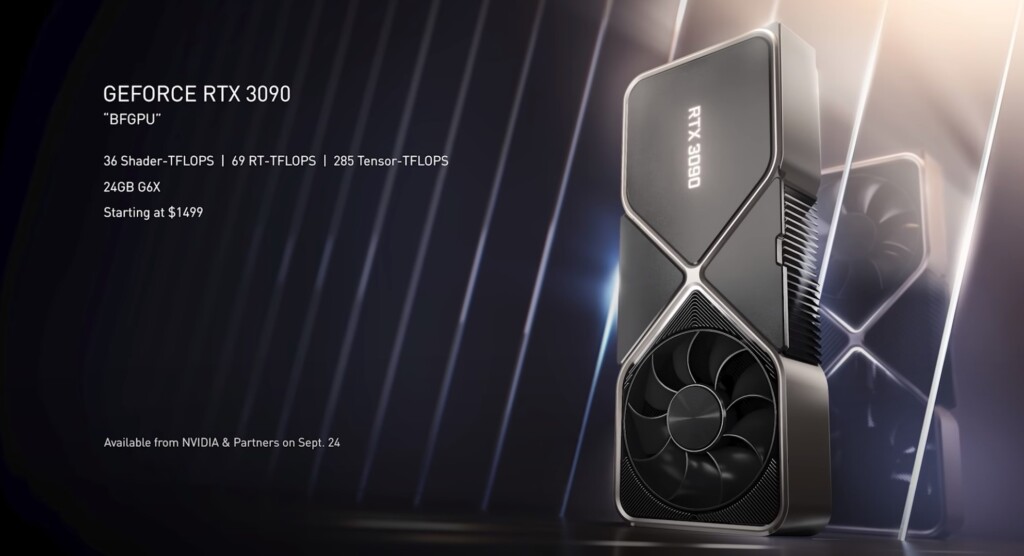
Everything You Need to Know About Nvidia’s 3000 Series Announcement
Nvidia finally unveiled their 3000 series in a live stream event last night, along with a plethora of technical details about the three new cards that will be coming out later this autumn. The improvements over the last generation are vast in terms of raw performance, so there’s plenty to talk about.
This generation of GPUs is based on the new Ampere technology, which was achieved in collaboration with Samsung and their 8N manufacturing process.
The other big news is the fact that, in a surprising move by Nvidia, the prices are actually coming down for once. Hence, we are getting more performance at a lower price, which is something that hasn’t happened in a long time.
Without further ado, let us dissect last night’s event and discuss all the major points of the presentation. Keep in mind that we are, at this point, going solely on Nvidia’s word, because none of the cards are out yet, and we obviously cannot put their claims to the test.
Three New Cards: RTX 3070, 3080, and 3090
First of all, the rumors were mostly true: Nvidia appears to have dropped the “Ti” and “Titan” monikers for this generation. However, the RTX 3090 seems to be this generation’s Titan, and not a Ti replacement like everyone thought. There is also nothing in between the 3080 and 3090, which means that the price gap is pretty substantial as well. Here is a short rundown of all three cards:
RTX 3070
Right off the bat, the 3070 is already more powerful than the 2080 Ti, which is quite frankly bonkers, especially at this price. That’s about 1500 more CUDA cores, or a ~35% increase in processing power over the last generation’s flagship.
For comparison, the RTX 2070 had 2304 CUDA cores - 1200 fewer than the 1080 Ti. It seems pretty obvious that Nvidia has managed to make some kind of breakthrough in terms of the manufacturing process, but we’re going to talk about that later.
The card also comes with 2nd generation ray-tracing cores technology, 3rd generation tensor cores technology, as well as support for the newly announced HDMI 2.1 and DisplayPort 1.4a. This is actually no different than the other two cards, but there are some missing features as well.
One of the things that is not present on the 3070 is the NVLink support, which allows you to connect two cards together. On the other hand, we are not actually sure that this is 100% true. Nvidia marked the “NVLink support” feature with a “Yes” for the 3090 and with a simple “-” for both the 3080 and the 3070, which could be taken as a “No”. Whether this is the correct interpretation remains to be seen, although all signs point to this being true.
The other thing that’s missing from 3070 is the GDDR6X memory technology used in the other two cards. That may not sound like much, but G6X is actually a significant improvement over the G6, which is also why the performance gap between the 3070 and the 3080 is so big - at least on paper.
Lastly, there’s also the price. $499 for a GPU that beats the 2080 Ti in terms of both specs and performance is an amazing deal. The current list price for the 2080 Ti is $1,190, so you can probably see why this is huge news. Those who have recently purchased a 2080 Ti are the real victims here, unfortunately.
RTX 3080
The RTX 3080 is this generation’s flagship according to Jensen Huang, Nvidia CEO. The specs definitely support this statement, especially when it comes to the number of CUDA cores. 8704 is exactly twice as many cores as the RTX 2080 Ti, while the price is $300 lower.
This is also where GDDR6X comes into play, which is the new memory technology developed by Micron. According to them, the I/O performance is double that of the old GDDR6 memory, mainly thanks to their new four-level pulse amplitude modulation (PAM4) technology. This is also why the 3070 is probably going to be a bit slower than the 3080 and 3090 since it doesn’t include GDDR6X.
Faster memory is nice and all, but we can’t help but notice that the old 2080 Ti comes with 11GB of VRAM instead of the 10GB we see on the fresh 3080. In theory, this shouldn’t affect performance at all, but it’s a bit weird to see a downgrade in memory capacity.
Lastly, the card is also a beast in terms of power consumption. At 320 Watts, this GPU will require a beefy power supply in order to keep it happy. Nvidia recommends a 750W power supply for your system, so keep that in mind if you are thinking about upgrading.
RTX 3090
So if the 3080 is this generation’s flagship, what’s the deal with the 3090? Well, it’s basically the new Titan, and it is aimed at people who want to push the boundaries in terms of gaming. While the increase in CUDA cores is not as significant over 3080, the memory capacity is vastly greater, not to mention the fact that the interface width is also a bit more generous at 384-bit.
In essence, this card is designed to handle gaming at much higher resolutions, as showcased during last night’s event. According to Nvidia, the 3090 is capable of 60 FPS at 8K, which is definitely impressive, even though most people won’t be able to afford 8K displays anytime soon.
This is also the only model that supports NVLink, which means that you can hook up two of them and get a whopping 48GB of VRAM to fit all those 8K textures required for high-resolution gaming. It should be pointed out that the reference card uses a 3-slot format instead of the usual 2 found on most high-end GPUs, so you will need a pretty hefty case in order to fit two of them next to each other.
As far as the price is concerned, this is actually on par with the usual Titan prices, so there are no surprises here. It’s a product for enthusiasts who are not really bothered by four-digit price stickers anyway, which makes sense.
Here is a direct comparison between all three cards:
New Software Technologies for Streamers, Machinima Creators, and Pro Gamers
Nvidia also used this event to announce some of the software technologies that are going to be released along with the 3000 series. Some of these are more exciting than others, but it’s definitely nice to see that the company is really trying to create useful tools for the people who buy their products.
Nvidia Reflex
Nvidia Reflex is designed with esports in mind, and it’s a technology that aims to reduce latency by up to 50%. This is achieved by optimizing the rendering pipeline across GPU and CPU, although there is not much information about how this is achieved.
Reflex is also going to go hand-in-hand with the new line of gaming monitors announced during yesterday’s event, which will run at a refresh rate of 360Hz (with G-Sync included, obviously). These monitors will be manufactured by all the major brands out there, including Asus, Acer, MSI, and Alienware. There are no details about pricing as of right now, and there is also no scheduled release date yet. Here are the four announced models so far:
- ASUS ROG Swift 360Hz PG259QNR
- Acer Predator X25
- MSI Oculux NXG253R
- Alienware AW2521H
We’ll keep an eye out for more details once more information is released later this year.
Nvidia Omniverse Machinima
Nvidia Omniverse is aimed at Machinima creators who like to create cinematics using real-time computer graphics, usually by making use of assets from various games and game engines. This practice isn’t new, since it actually became a thing over a decade ago, but for some reason, Nvidia has only recently stumbled into this.
The Omniverse tool allows you to import assets from a variety of libraries and video games, and then combine them with all sorts of new gimmicks brought on by the new RTX generation. This includes a very nifty tool that enables you to create lip-sync animations using just an audio file, and it’s actually language-agnostic. In short, you can use an audio clip of you talking in whatever your native language is, then automatically create facial animations for your 3D model based on that audio clip.
Furthermore, there is also a mocap component that allows you to animate your characters using simple videos - or at least that’s the impression we got from the presentation. There seems to be no need for actual mocap gadgets, so that’s very cool.
Nvidia Broadcast
Nvidia didn’t forget about streamers either, which is why the new Broadcast app is going to bundle even more interesting features. The most exciting part is the ability to automatically remove your background while streaming and replace it with custom photos or animations.
You can think of this as using green screen effects without having an actual green screen behind you while streaming. The video showcased during the presentation demonstrated this technology, although we have to say that it’s not exactly perfect at the moment.
Even so, the glitches are bound to be fixed later on, and the demo looked pretty convincing even in this early stage. This is definitely going to be a great tool for any streamer, especially since it significantly reduces the costs that come along with having to use a green screen.
The New “Marbles” Tech Demo: “Marbles at Night”
Nvidia was also eager to unveil an updated version of their “Marbles” tech demo that was first released to the public during the initial RTX launch a few years ago. If you are not familiar with the demo, it’s basically a real-time rendering of a marble as it rolls across a few obstacles on a desk. The main purpose of the demo was to showcase real-time ray tracing on a single GPU, which was not possible before that.
“Marbles at Night” is the newest version of this demo that runs on the Ampere architecture, and it’s actually a lot more impressive this time. The resolution was upgraded to 1440p from 720p, and no rasterization techniques were used at all. There are also more light sources in this version, as well as better physics simulation, which also runs in real-time.
Here is the video in question in case you are curious:
Better Yields During the Manufacturing Process?
There’s no denying the fact that the whole tech world was stunned by this new generation of cards, mainly because of the prices. Even though these new GPUs are in some cases twice as powerful as the last generation, the prices are somehow lower, which doesn’t quite make sense from a financial point of view. So why is Nvidia so eager to sell us their new shiny GPUs at such low prices?
Well, one possible reason is their collaboration with Samsung when it comes to the manufacturing process. Just like with CPU dies, GPU dies often come out with imperfections that make them unusable. Obviously, Nvidia (and companies like Intel or AMD) will never release their yield rates, because they are close-guarded industry secrets.
However, it would appear that Nvidia and Samsung managed to get very good yields for this generation of GPUs, which is why they can afford to make more of them and sell them at a lower price, while still turning a profit. This should also mean that the number of available units will be higher, although this is all speculative at this point.









